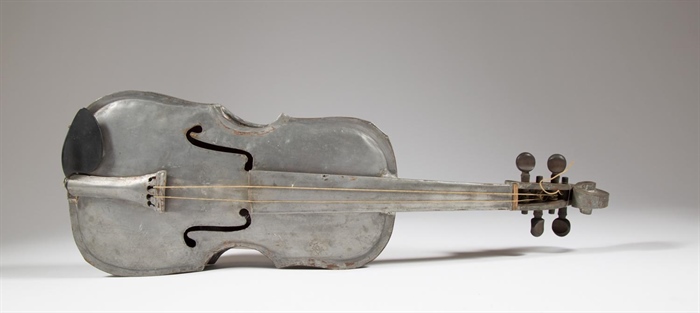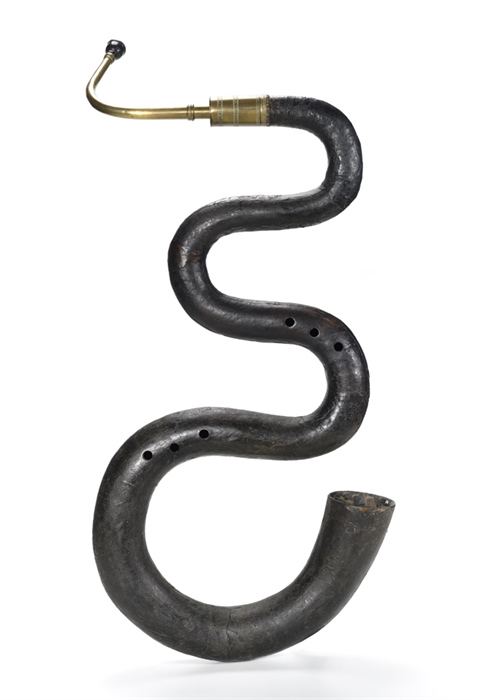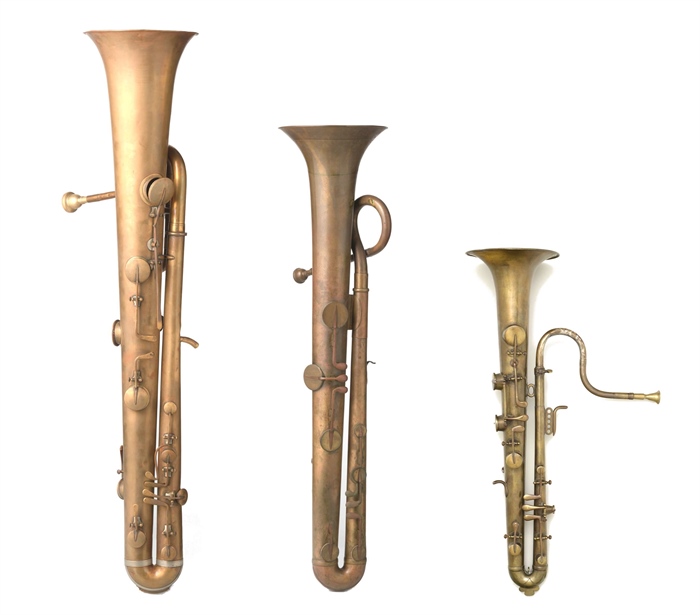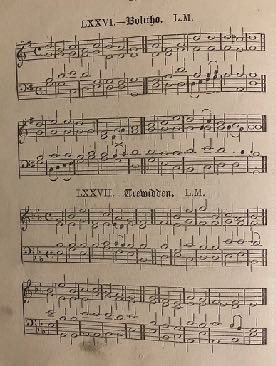
A snuff box lid depicting West Gallery musicians
‘West Gallery Music’ has been defined by a leading exponent, Rollo Woods, as:
‘The sacred music of Anglican and Non-Conformist Churches in villages and towns between c.1740 and c.1860, where the singing, whether by choir or congregation, was accompanied, not by an organ, but by a small group of instrumentalists, who usually sat in a purpose-built gallery at the west end of the church.’
West galleries were found across the country, particularly in rural areas, where the cost of providing an organ was beyond budget.
During the Commonwealth Oliver Cromwell banished music in churches and many organs were destroyed. Music was restored to church after 1660, and local musicians provided the music for services, especially in rural areas. Nationwide there was no standard repertoire of hymns and anthems, and much variation in the musical ability of musicians, composers and choir members. Generally the bands played any instruments that were available, some string, some wind, and many were homemade.
A tin violin hung in a church in north Cornwall for many years, and the instrument that was on display for some time in the Royal Cornwall Museum, Truro provided inspiration for Alan Kent’s play about musician Joseph Emidy, The Tin Violin.

Early 20th century tin fiddle
Early church records show the use of pitch pipes and tuning forks - expensive items in those days. Madron Church had a tuning fork in 1814, and Lelant Church records show a pitch pipe being used between 1812 and 1816.

Two pitch pipes, the larger marked for the key of F, and a MS book with handwritten Tunes, the book belonging to R.T. Prior and dated 1836. Mr Prior would appear to be the composer of the tune Persia.
Other instruments recorded in Cornwall included violin, bass viol, hautboi or hobo, (a forerunner of the oboe) and bassoon keyed bugle (a military instrument). There were 13 serpents (see example below) in the county, and seven ophicleides (pictured below).

Serpent
Manifattura_italiana,_Serpentone,_fine_sec._XVIII._Museo_Civico_di_Modena,_foto_P._Terzi

Examples of brass ophicleides
CC0-licensed images from the Rijksmuseum and The Metropolitan Museum of Art File:Basophicleïde, BK-NM-11430-46.jpg File:Altophicleïde, BK-KOG-2719.jpg, and File:Soprano ophicleide in B-flat MET DP249514.jpg, resized and cropped to illustrate the main types and sizes of ophicleide, to scale.
Every band had its own unique sound depending on the blend of instruments. Researching through all the parish records, Harry Woodhouse found evidence of bands in 168 churches and chapels in Cornwall – including a barrel organ at Gulval, a piccolo at Hellesveor and a French horn at Mousehole. 18 parishes still featured a band in church services as late as 1900. A full list of Woodhouse’s West Penwith references is added at the end of this article as an appendix
In this period, music was mostly printed abroad and very expensive, so it was copied by instrumentalists and choir members into their own books - singers often wrote down their own line only. These books, when found, are nowadays a primary source for researchers. The tunes were mostly in 4-part harmony with the tune in the tenor line, and fuguing, that is entry at different times by the four parts, was common.
Many tunes were named after place names Examples are ‘St Austle,’ Helston, Kehelland, and - in West Penwith - Calynack, Trethewey and St Leven.
Richard Jones of Penzance published The Cornubian Tunebook in 1870 (pictured below), with hymns named after local families such as Bolitho, Borlase, Glasson, Hedgland, Vingoe, and Wingfield.

A page from The Cornubian Tune Book by Richard Jones of Penzance,
with local names to the tunes
Many factors brought about the demise of the West Gallery style of religious singing. The Victorians were keen to update and improve their churches, and the removal of galleries and box pews in the mid-1800s was seen as modernising. The Oxford (Tractarian) Movement developed the ‘high’ church type of service, and the installation of organs became widespread. The country choirs gradually became redundant and the early psalmodies and hymns, so lovingly copied out in their manuscript books became obsolete. Hymns Ancient & Modern, published in 1861, became the national standard, enabling congregations to participate more in services.
It is believed that the last full chapel band with six members was still playing monthly, without the organ, at Sithney near Helston in the early 1950’s - and we would be interested to hear of any later sightings.

A Village Choir Thomas Webster 1847
The West Gallery style of singing may have gone from churches and chapels – but it has not entirely disappeared. Scholars and folk music enthusiasts started a revival in the late 1970’s, and the West Gallery Music Association was founded with the aim of researching and keeping alive this old music. Many manuscripts have been found in searches of libraries and archives, and choirs today are once again singing this material.
In the 19th and early 20th centuries, the tradition of “Going the Rounds”, that is choir carol singing from house to house, at Christmas was an important rural tradition and continues to this day in some parts of the country. Cornwall has a rich tradition of carol singing in four-part harmony, which has spread worldwide as the miners moved away from home in search of work. Different versions of carols can be found from village to village as new compositions spread over the county. Many collections of local and self-penned carols were published in the 19th and 20th centuries, and the latest publication is Carols of St. Ives - Published in celebration of the Centenary of St Ives Old Cornwall Society in 2021
Also worth noting is the work of Hilary Coleman and Sally Burley, which led to the book Hark the Glad Sound of Cornish Carols (published 2017). You can watch them talking about, and a choir performing, the carols they found all over Cornwall – including ‘Tom Bowcock’s Eve’ 27 minutes in - here https://youtu.be/tT_FG-A5lg8
Linda Collins December 2023
References
- Miles Brown The Church in Cornwall, Oscar Blackford Ltd 1964
Micheal Dundrow, Margaret Dundrow and Ann Jenkin Madron’s Story, Bossiney Books 2001
Richard Jones The Cornubian Tune Book, William Cornish, The Library, Penzance, 1870
Richard McGrady Music & Musicians in Early 19th Century Cornwall, University of Exeter Press 1991
Harry Woodhouse Face the Music, Church & Chapel Bands in Cornwall, Cornish Hillside Publications 1997
R G Woods Good Singing Still: A handbook on West Gallery Music, West Gallery Music Association 1995
St Ives Museum: Manuscript of Christmas Carols by local composers recently transcribed by Peter Meanwell (Washaway West Gallery Choir), and published by Kernow Goth as Carols of St Ives 2022
Appendix:
The list below is extracted largely from Face the Music, Church and Chapel Bands in Cornwall, appendix 1. It relates to the churches and chapels in West Penwith with records of musical instruments, the implication being that a band played for anthem, hymn and psalm singing at their services. References have been verified and detail added where possible.

‘Face the Music’ ISBN 1-900147-07-6
Gulval: Clarinet 1824, Barrel Organ/Finger Organ 1847 (‘church guide’)
Hayle St Elwin: Musicians gallery (‘church guide’)
Lelant: Band 1737, gallery 1751, pitch pipe 1760, organ 1908 (‘CRO church accounts, DDP series’)
Ludgvan: Gallery 1798-1833, bass viol 1824-56, violin 1837-56, clarinet 1839-53, bass horn 1856, organ 1860 ‘(CRO church accounts, DDP series’; ‘church guide’)
Madron: Bass viol 1806-38, 2 clarinets 1808-27, violins 1813-14, gallery 1836, flute 1827, organ 1840, barrel organ until 1859 (‘CRO church accounts, DDP series’; ‘church guide’). Orchestra 1750 (D Cox Madron Parish Church undated). Madron had six band members (Face the Music p 81), and other evidence of a band includes notes from the Churchwarden’s accounts, covering items such as Psalm books, books for copying down the music, candles for the gallery, and expenses for several outings to other churches or visiting local choirs. (Madron’s Story pp 32-34)
Marazion: Bass viol 1805-14, gallery 1841 (‘CRO church accounts, DDP series’, T Reynolds The Churches and Chapels of Market Jew 1963)
Mousehole: Violin, bass viol, flute c. 1860 (Thomas Shaw A History of Cornish Methodism 1967)
Mousehole Wesleyan Chapel: Violin, viola, bass and French horn until harmonium 1879. Organ 1903 (John C C Probert The Worship and Devotion of Cornish Methodism 1978). On Christmas Eve 1860 the choir visited Paul (Face the Music p 92).
Penzance ‘Organ Church’ Wesleyan Chapel: Band walked out when organ was installed (private communication to Harry Woodhouse)
Perranuthnoe: Bass viol 1818-1833, clarinet 1831-34, organ 1884 (‘CRO church accounts, DDP series’)
Phillack: Bass viol 1804-34, clarinet 1809-30, violin 1819 (‘CRO church accounts, DDP series’)
St. Buryan: Clarinet 1817, violin 1826, bass viol 1827, harmonium 1880 (‘CRO church accounts, DDP series’)
St Erth: Band played in Church in the morning and Chapel at night (John C C Probert The Worship and Devotion of Cornish Methodism 1978)
St Ives Church: Gallery 1639-1840, bass viol, clarinet (John Hobson Matthews A History of the Parishes of St Ives, Lelant, Towednack and Zennor 1892 p 71 )Barrel organ 1831 (‘local museum guide’, Lyndesay Graham Langwill Church and Chamber Barrel Organs 1970 p 70
St Ives Fore Street Chapel: Violins, cello, clarinet (John C C Probert The Worship and Devotion of Cornish Methodism 1978)
Hellesveor Chapel near St Ives: Cornet, clarinet, ophicleide, 1874 (Thomas Shaw A History of Cornish Methodism 1967). Violin, euphonium 1911 (‘local museum guide’). Bass viol and piccolo (John C C Probert The Worship and Devotion of Cornish Methodism 1978)
St Ives Methodist New Connexion Chapel: Organ, French horn, and clarinet? 1898 (John C C Probert The Worship and Devotion of Cornish Methodism 1978)
St Ives Teetotal Chapel: Organ and cornet, 1896 (‘local museum guide’)
St Just in Penwith: Gallery removed early 19th century
Sennen: Had a band (K H McDermott The Old Church Gallery Minstrels 1948 listed in appendix 1)
Zennor: Gallery 1722, bass viol 1830, clarinet 1833 (‘CRO church accounts, DDP series’). Flute and violin before c. 1890 when the gallery, built in 1772, was removed (P A S Pool A Cornish Farmer’s Diary 2nd edition 1978 p 12)
Cornish Music Guild archive: Local carols collected by Thomas Banfield of St Ives (Face the Music p 70)

Penwith Local History Group

Edited by
Sally Corbet
price £10
plus p&p